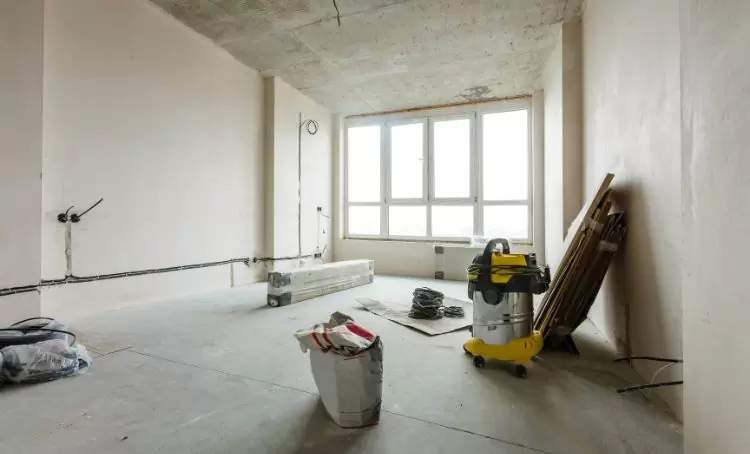Navigating the diverse real estate market of New York can be a daunting task for any real estate investor. With varying market conditions across different regions and communities, ensuring the profitability of a fix-and-flip project poses a unique challenge.
At Express Capital Financing, we understand the complexities of the New York real estate landscape, which is why our expert team has crafteda simple yet powerful 5-step strategy to help house flippers maximize their investments. Whether you’re an experienced flipper, or this is your first step into the fix-and-flip market, this guide will help you up your investing game.
What is home flipping?
Home flipping is a real estate investment strategy where an investor purchases a property to renovate it and sell it for a profit.
This practice involves buying outdated and distressed properties, making necessary improvements to increase their value, and then selling at a higher price than the initial purchase.
Flipping homes requires a deep understanding of the real estate market, renovation costs, and the ability to accurately assess the potential return on an investment property.
Successful flippers can quickly identify distressed properties with potential, execute cost-effective renovations, and ultimately sell the property for a significant profit.
This strategy is popular among real estate investors looking for short-term gains and the chance to showcase their skills in property rehabilitation and market analysis.
However, flipping homes also comes with risks that first-time flippers should be aware of. Things like unexpected renovation and repair costs, market fluctuations, and the potential for a property to not sell at the desired price.
Overall, flipping homes requires careful planning, thorough research, and a keen eye for identifying profitable investment opportunities.
Benefits of Flipping Homes in New York City
As one of the hottest markets in the US and with positive market conditions, flipping homes in New York City offers a range of benefits to real estate investors.
Firstly, lower property prices are often available in certain neighborhoods, allowing for affordable acquisition of properties with the potential for significant appreciation.
What’s more, there is a consistently high demand for housing in New York City, providing ample opportunity for quick sales and profitable returns on investment. The favorable tax laws in the city can also help to maximize profits for real estate investors, making it an attractive location for flipping houses.
On top of all that, New York City possesses a business-friendly environment, with a wide range of resources and support available for real estate entrepreneurs, further increasing the appeal of investing in this housing market.
These potential advantages combine to make New York City an appealing location for both experienced and novice real estate investors seeking to capitalize on the opportunities for flipping houses.
Understanding the Real Estate Market in New York City
Navigating the real estate industry in New York City can be a daunting task. With its diverse neighborhoods, fluctuating property values, and competitive nature, it’s essential to have a solid understanding of the market before diving in.
From understanding the key factors driving the housing market to knowing the best time to buy or sell, having a grasp on the real estate landscape in NYC is crucial for a successful flip. Let’s take a look at the various aspects of the real estate market in the Big Apple.
Real Estate Trends & Prices
The current real estate market in our local area is experiencing high demand and limited supply, leading to an increase in average sale prices.
The low inventory of homes for sale has caused prices to rise, with the average home price increasing by 10% over the past year. This has created a competitive market for buyers, often resulting in bidding wars between potential buyers and homes selling above the asking price.
Current economic conditions, such as low mortgage rates and a growing economy, have fueled this increase in demand for real estate. As a result, experts forecast that purchase prices will continue to rise in the near future, as the demand for housing remains strong.
Looking ahead, it is expected that the real estate industry will continue to be influenced by economic factors such as employment rates, inflation, and interest rates. As the economy continues to recover, it is likely that real estate prices will remain on an upward trajectory, making it a seller’s market for the foreseeable future.
Demand for Housing
The current demand for housing is being driven by several factors. Population growth is a significant contributor, with an increase in the number of households creating a higher demand for homes. Economic factors such as low mortgage rates and strong job markets are also driving the demand for housing as people seek to take advantage of favorable financial conditions.
Housing inventory levels are playing a key role in shaping demand, with limited availability in many markets leading to heightened competition among buyers. This shortage of supply has also led to increased housing prices, impacting affordability for many potential homebuyers.
Notable trends in housing demand include a shift towards suburban and rural areas as remote work becomes more common, as well as a growing preference for larger homes with dedicated office spaces. These trends are impacting the types of properties that are in highest demand.
Property Taxes
Property taxes in our local area are calculated based on the assessed value of the property and the applicable tax rates. The assessed value is determined by the local government’s assessor and is typically based on the property’s market value. The tax rates are set by local government entities, such as the county or municipality, and are used to calculate the amount of tax owed.
Homeowners may be eligible for deductions or exemptions that can lower their property tax burden. These can include homestead exemptions for primary residences, deductions for veterans or disabled individuals, or tax credits for energy-efficient upgrades. Homeowners need to understand these options and take advantage of them to reduce their property tax expenses.
Understanding how property tax rates are determined is crucial for property investors as it directly impacts their homeownership costs. Higher tax rates can increase the overall cost of owning a home, making it important for potential homebuyers to factor property taxes into their housing budget. Being aware of the potential impact of property tax rates can help real estate investors make informed decisions about where to purchase a property and how to manage their fix and flip.
Crime Rates
The current crime rates in the area have shown a decrease in violent crimes over the past year. According to the most recent data from the local police department, violent crimes have decreased compared to the previous year. This includes a decrease in reported cases of assault and robbery.
However, property crimes have shown a slight increase, primarily due to a rise in reported cases of theft and vandalism. While overall crime rates have slightly decreased, there has been a recent trend of an increase in property crimes.
The local data also indicates that there has been a focus on community policing and proactive measures to address specific crime hotspots, which has contributed to the overall decrease in violent crimes. In addition, the increase in property crimes has prompted an increase in neighborhood watch programs and collaboration with local law enforcement agencies to address the issue.
Financing a Home Flip in NYC

Whether you are a seasoned real estate investor or a first-time home flipper, understanding the financing options for NYC flips is essential for a successful and profitable venture.
Obtaining Traditional Mortgages
Obtaining traditional mortgages for a house flipping project in New York typically requires a good credit score, usually around 620 or higher, and a down payment of at least 20%. Additionally, the property will need to undergo a thorough appraisal process to determine its value and suitability for financing.
When it comes to financing options for house flipping, traditional bank loans offer competitive interest rates, but may have stricter requirements and longer processing times. Hard money loans are an alternative option with higher interest rates and are short-term loans, but they provide faster funding and may be more accessible for those with less-than-perfect credit. Private lenders and home equity loans are also potential financing sources, each with their own unique terms and requirements.
Comparing financing options for house flipping projects involves considering factors such as interest rates, fees, and the speed of funding. It’s important to weigh the advantages and drawbacks of each option to determine which best fits the specific needs and circumstances of the project.
Working with Private Money Lenders
When working with private money lenders, transparency and honesty are crucial. It is important to openly discuss your intentions for the property and to provide realistic timelines and improvement plans. This builds trust and ensures that all parties are on the same page. Finding a reputable lender is crucial to avoid fraudulent schemes. Beware of suspicious claims of low-interest rates and no money-down offers, as these often indicate a scam.
Approaching private money lenders involves providing detailed information about the property, the improvement plans, and a clear financial strategy. This includes being transparent about your financial situation and demonstrating the ability to repay the loan.
It’s important to thoroughly research potential lenders and check their reputation before entering into any agreements. By being honest and upfront about your intentions and by working with a reputable lender, you can mitigate the risk of mortgage loan fraud and ensure a successful partnership.
Qualifying for Loans to Fund the Flip
When it comes to funding a flip, there are several loan options available to investors. Hard money loans are a popular choice for short-term financing, offering quick approval and funding with less emphasis on credit and financial history. However, they typically come with higher interest rates and fees.
Fannie Mae’s HomeStyle Renovation loan and FHA 203K Mortgage are both government-backed loan options that can be used for purchasing and renovating a property. As opposed to short-term loans, these loans offer more affordable interest rates and longer repayment terms, making them a more attractive option for those looking for a traditional financing route. The FHA 203K Mortgage is specifically designed for owner-occupants, while the HomeStyle Renovation loan is available for both owner-occupants and investors.
The best financing option for a flip will depend on the individual’s financial situation, credit history, and investment goals. A hard money loan may be beneficial for those who need quick financing and have a strong exit strategy in place, while Fannie Mae’s HomeStyle Renovation loan and FHA 203K Mortgage are great options for those looking for more affordable rates and longer repayment terms.
It’s crucial to weigh the benefits and drawbacks of each financing option and choose the one that aligns with your specific needs and goals.
Closing Costs and Other Costs Associated with a Flip
Flipping a house in New York involves various closing costs and expenses. The acquisition costs typically include expenses such as property appraisal fees, title insurance, attorney fees, and loan origination fees. Renovation costs can vary widely depending on the extent of the renovations needed but often include materials, labor, permits, and utility expenses.
Funding options for flipping a house in New York can include traditional bank loans, private lenders, or hard money short-term loans, each with its own associated costs such as interest rates, points, and loan origination fees. Additionally, there are also ongoing holding costs such as property taxes, insurance, and utilities that need to be factored in.
When it comes to purchasing investment properties in desirable locations, potential costs can be higher due to the demand for properties in those areas.
This can include higher acquisition costs, more competitive renovation bids, and potentially higher financing costs. However, investing in desirable locations can also lead to higher returns on the investment if the property is properly renovated and marketed.
It’s essential to carefully calculate all potential costs involved in purchasing and renovating a property in a desirable location to ensure a successful investment.
Our 6-Step Guide to House Flipping in NY

1. Take a Drive
It may sound odd in the age of GPS and Google Maps, but taking a drive to look at homes is extremely helpful.
If you’re lining up a specific house in an area, taking a drive can help to give you an idea of what the neighborhood is like. Driving around also helps to size up any added features which could be leveraged when listing a house.
- Is it a quiet area?
- Are there good schools nearby?
- How far away is the nearest grocery store?
- What about access to healthcare facilities?
- How busy are the roads during morning commutes and the evening rush hour?
Potential buyers are going to have a lot of questions, and being able to provide answers will get you closer to a sale.
2. Compare Listings in Upstate NY
Successful house flippers in Upstate NY have to do a little research on the local property markets.
Obviously, a single-family home on Long Island is going to have a different sale price compared to Utica or Oswego.
Flipping homes in Upstate NY involves a bit of comparison shopping. If you’ve lined up a property, take a look at what similar homes are going for in that area.
3. Always Get an Inspection
We cannot stress this enough. Homes in Upstate NY are of all sizes and ages.
Getting a third-party inspection will give you an idea of how much renovation work needs to be done, as well as any potential hazards.
The last thing any house flipper wants is to budget for a simple renovation, only to find out the whole house has the old knob and tube electrical work that needs to be overhauled or to find one of the few homes in the state that still needs asbestos removal.
4. Budget With Care
When budgeting for a fix and flip project, there are a few things to consider.
First, do not go above your purchasing budget. Bidding wars sometimes ensue when a few potential buyers are looking at properties. The only winner in those situations is the seller, and counteroffers will only eat into your profit margin.
Second, leave yourself some cushion for the unexpected. If something needs to be replaced, you want to have capital available to cover the expense.
Also, don’t go for the cheapest materials and fixtures. You don’t have to go top shelf, but buyers are willing to pay extra for a nice backsplash, durable engineered hardwood floors, and decent countertops.
Put aside some extra capital for staging, as well. Renting some furniture to give buyers an idea of what the home looks like when it’s furnished helps to close transactions a lot faster.
5. Use a Real Estate Agent
When it comes to flipping homes in New York, it is important to find a qualified and experienced real estate agent who can help you navigate the complex process, from identifying properties with potential to securing the best sale prices. Whether you are just starting out or have flipped multiple properties, finding the right agent can make all the difference between success and failure.
The first step in finding a real estate agent is to do your research. Check out online reviews of agents in the area and ask friends and family for referrals. Also make sure to check out the wide range of real estate websites to compare the agents. Once you have narrowed down your list, it’s important to meet with each agent and make sure they understand your goals and are familiar with the local market.
If you’re aiming to be in the property game for the long run, finding a real estate agent partner you can trust will make your life so much easier.
6. Get Financing for Your Real Estate Investment
Whether you’re new to the game or an experienced flipper, one of the necessities in real estate investing is finding a trustworthy financing partner.
At Express Capital Financing, we provide funding for house flippers throughout the state of New York and beyond.
Talk to our team today, and we will provide a solution tailored to your needs, to ensure success on your next house-flipping project from start to finish.
FAQ
House flipping is a term used to describe the process of buying and selling homes for profit. It is a popular form of real estate investment that involves buying a property, renovating it to increase its value, and then reselling it for a higher price than what was initially paid.
Flippers usually begin by purchasing a home below market value in an area with potential for appreciation. They then make necessary repairs and upgrades to the property, such as remodeling kitchens and bathrooms, replacing flooring or appliances, and making cosmetic improvements. After the renovations are complete, they list the property for sale at a higher price than what was initially paid.
Yes, you can flip houses in NY. Flipping homes is a popular strategy for real estate investors who are looking to make a quick profit by buying, renovating, and then selling properties. This strategy requires an understanding of the real estate market in order to identify potential investments and determine how much money can be made from the sale.
Before investing in flipping homes in NY, it is important to get a professional real estate agent, secure financing, and research the local market in order to ensure success.
When it comes to flipping houses, there are many different states that offer great potential for success. However, one of the most popular places to flip houses is New York. This is due in part to the fact that it is home to a large population of affluent buyers and sellers, as well as having some prime real estate opportunities in desirable parts of the state.
New York offers plenty of potential for house flippers to make a significant profit, so if you're looking to get into the real estate game, it is definitely worth considering.
To help with all of these questions and more, we've put together this handy guide on evaluating fix and flip properties.
Flipping a house can be a rewarding experience but it typically involves a significant amount of time and effort. The timeline for flipping a house can vary greatly, depending on the size and condition of the property, the amount of renovations needed, the real estate market in your area, and other factors.
In general, most home flips take around 6 to 12 months to complete from start to finish, but it is possible to do them in a shorter amount of time. It is important to take your time and plan ahead for each step of the process in order to ensure you maximize your profits.






